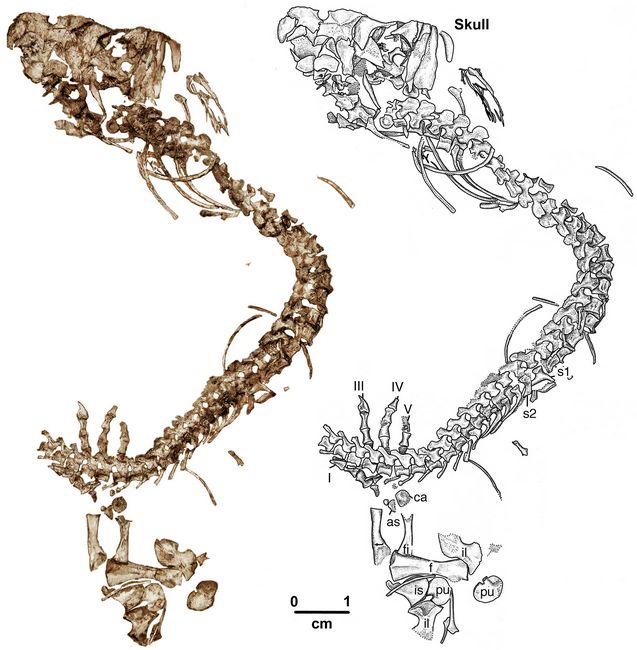Athena Review Image Archive ™
Eocasea martinis skeleton

Skeleton of Eocasea martinis (after Reisz and Frobisch 2014).
A juvenile fossil of Eocasea martinis was found in Late Pennsylvanian Calhoun Shale Formation in Hamilton Quarry in Greenwood County, Kansas. dating from 300 mya. This locality, a fossil lagerstatte (sedimentary deposit with extraordinary fossil preservation) represented a tidally influenced valley in the Late Pennsylvanian period, where a diverse flora and fauna has been preserved, including fish and amphibians.
The Eocasea martinis fossil (KUVP 9616b, at the University of Kansas Museum, with the species named for Dr. Larry Martin) includes the pelvic girdle and the right hind limb preserved along with most of the vertebra and the skull, the latter in crushed condition. The E. martinis juvenile has been interpreted by Reisz and Fröbisch (2014) to belong to the Caseid group, which included both carnivores and herbivores, and ultimately evolved into mammals. As such, it represents the earliest synapsid fossil yet known.
Eocasea represents an herbivore, about 15 cm long, with a narrow rib cage, simple cone-shaped teeth, and a much smaller body size than later caseids which had wide bodies and specialized, serrated teeth for chewing plants. The finding of Eocasea closes a gap of about 20 million years to the next youngest members of the caseid family, indicating that caseid synapsids were earlier than previously known from the fossil record. Caseids were one of the first groups of tetrapods to evolve into herbivores.
The term synapsid ( “one arch” or "one opening") was originally used by Romer (1956) as a grouping of the class of reptiles, referring to those whose skulls had one aperture on each side, as contrasted to both anapsids (“no arches”) and diapsids (two arches). The term synapsid is now used to distinguish the reptilian ancestors of mammals from the ancestors of later reptiles, who split from each other quite early. Eocasea lived not very long after the earliest reptiles, who were amniotes, were derived from non-amniotic amphibian reptiloforms, which occurred during the Mississippian or Early Carboniferous period at about 315 mya.
References:
Reisz, R.R. and J.Fröbisch 2014. The Oldest Caseid Synapsid from the Late Pennsylvanian of Kansas, and the Evolution of Herbivory in Terrestrial Vertebrates. PLoS ONE. 9 (4).
.
Copyright © 1996-2020 Rust Family Foundation (All Rights Reserved).